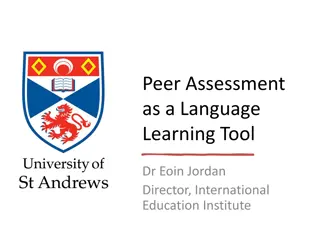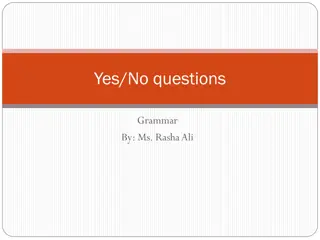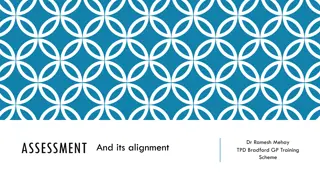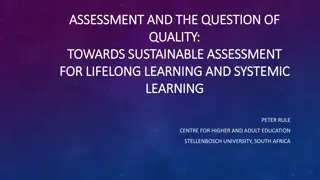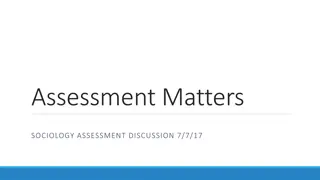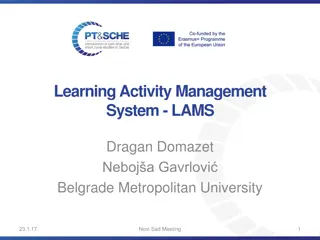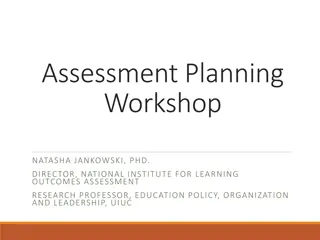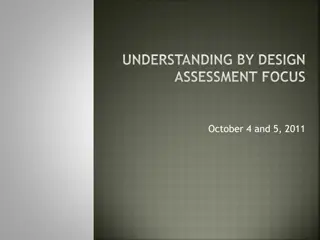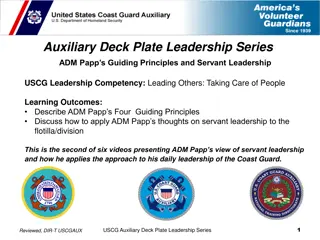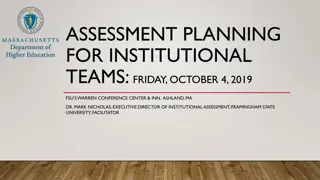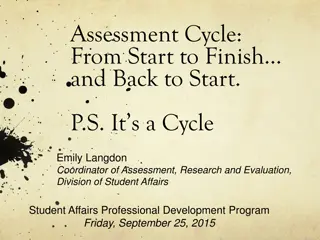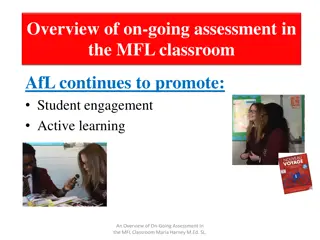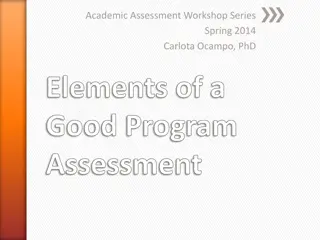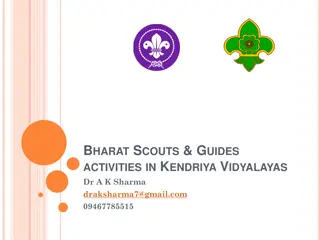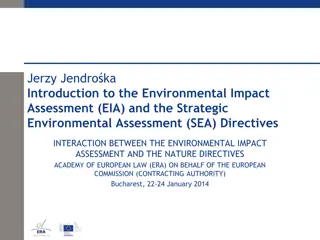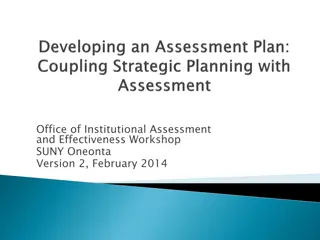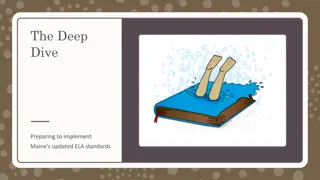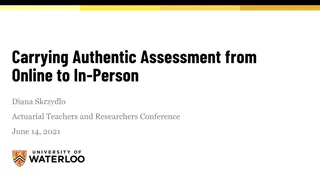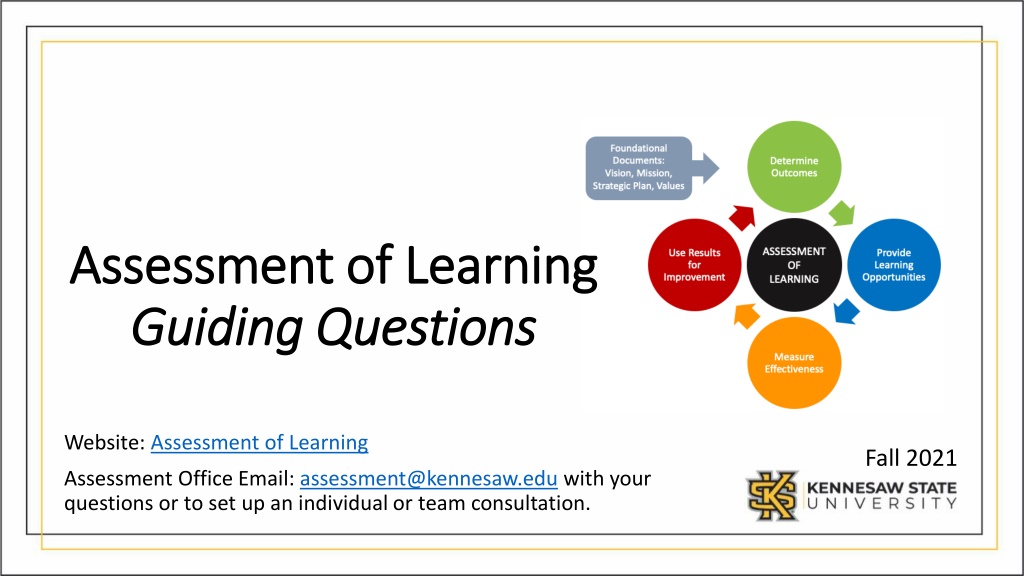
Enhancing Assessment Strategies for Effective Learning Outcomes
Explore the importance of guiding questions in assessing learning outcomes, determining SLOs, and measuring effectiveness. Learn how to make assessments more meaningful through purposeful reflection and discussion, focusing on improvement strategies, and aligning assessment measures. Engage in discussions to enhance student learning experiences and program effectiveness.
Download Presentation

Please find below an Image/Link to download the presentation.
The content on the website is provided AS IS for your information and personal use only. It may not be sold, licensed, or shared on other websites without obtaining consent from the author. Download presentation by click this link. If you encounter any issues during the download, it is possible that the publisher has removed the file from their server.
E N D
Presentation Transcript
Assessment of Learning Assessment of Learning Guiding Questions Guiding Questions Website: Assessment of Learning Fall 2021 Assessment Office Email: assessment@kennesaw.edu with your questions or to set up an individual or team consultation.
Purposeful Reflection and Discussion Purposeful Reflection and Discussion Programs can make assessment more meaningful and manageable by: Focusing on outcomes and measures most in need of improvement, Discussing assessment results and improvement strategies at faculty meetings, Implementing targeted strategies to improve learning and your overall program, and Reporting on the continuous improvement activities that are already taking place. Use the following questions to guide your discussions of assessment at faculty meetings.
Guiding Questions: Determine SLOs Guiding Questions: Determine SLOs What do we want students to get out of this learning experience? What do we want them to be able to do long after the program or course is completed? Why are those things important? What do our students do after they graduate? What are the most important things they need for success in those pursuits? What do we value most about our discipline? According to the major authorities in our discipline, what are the most important things students should learn? Does each SLO clearly articulate the knowledge, skill, and/or ability students will demonstrate? Is each SLO discrete and specific (focuses on only one main area of knowledge, skill, or ability)? Is each SLO observable and measurable (described using action verbs; see Bloom s Taxonomy)? Does each SLO align with the expected level of learning for the course and degree (i.e., higher levels of thinking for upper-level courses and advanced degrees)? What specific learning activities will help students achieve the learning outcomes? What SLOs will we focus on for continuous improvement( (two required)? Where do students struggle the most? For new programs, where do we think students will struggle the most?
Guiding Questions: Measure Effectiveness Guiding Questions: Measure Effectiveness How will we know if students have achieved the learning outcomes? What assessments will best provide evidence of outcome achievement? Do the measures align with the outcome (content validity)? Do we have at least one direct measure of student learning for each outcome? Are the measures sufficiently granular to collect specific evidence (i.e., exam, rubric, or survey items as opposed to overall grades or holistic scores)? Does the level of learning described by the action verb in the SLO align with the level of learning measured by the assessment instrument? Are rubrics well defined (with specific criteria, appropriate rating scale, and clear descriptors at each performance level)? What, if any, challenges might arise during data collection? Do we need a process for artifact sampling (i.e., for courses with high enrollment or across course sections)? How will the assessment data be analyzed? Who will analyze it?
Guiding Questions: Interpretation of Results Guiding Questions: Interpretation of Results What does the data tell us? What trends and relationships do we see in the data? In what areas are students consistently demonstrating high performance in relation to the learning outcomes? In what areas are students consistently struggling or on the verge of not meeting performance expectations based on the learning outcomes? How are some students performing compared to others? Are there any patterns that need to be addressed? What questions should we explore further across this set of data? Are there other sources of data we should explore?
Guiding Questions: Diving Deeper Guiding Questions: Diving Deeper What factors may be contributing to these results? Perform a root cause analysis (the 5 Whys ; fishbone diagram) Examine each of the following factors and determine how they may contribute to the assessment results: Course content and materials Learning process and environment Teaching practices and style Student-related factors External factors
Guiding Questions: Strategies for Improvement Guiding Questions: Strategies for Improvement What strategies for improvement can we implement to address these issues? How will we support the struggling students in the class or program? How do the assessment results inform potential changes in teaching strategies and/or curriculum? What are the specific action steps needed to implement the strategies? What are the timeframes for each action step? Who else needs to be involved? What resources do we need?
Guiding Questions: Evaluation of Strategies Guiding Questions: Evaluation of Strategies After implemented, did the strategy and action steps have the desired impact? Was there a change in student learning? Are we seeing increased engagement with the course material? Is there incremental improvement in student retention or graduation rates? (This will take time, so persistence is key.) Do we need to modify our strategies for improvement? Remember, if a change does not lead to improvement, it s okay -- try something else
Guiding Questions: Review the Assessment Plan Guiding Questions: Review the Assessment Plan Should the assessment plan or process be modified? Are the SLOs still relevant and aligned with industry needs? Based on the data, are the outcomes still a priority for improvement? Are measures sufficiently granular to assess only the learning outcome of interest? Are test items and rubrics clearly worded and aligned with the learning outcomes? Are rubrics well defined (with specific criteria, appropriate rating scale, and clear descriptors at each performance level)? Do the assessment instruments demonstrate acceptable reliability and validity? How can we improve our data collection and/or data analysis process?
Culture of Continuous Improvement Culture of Continuous Improvement Begin with a core set of institutional values Communicate expectations and model the process Involve all facets of the university Utilize and build on existing tools and programs Identify and communicate common ties among initiatives Communicate how assessment results have been used for improvement Keep continuous improvement top of mind and part of the institutional lexicon Enhance data/information literacy skills among faculty and staff Encourage academic innovation -- test novel or innovative solutions Integrate with HR systems: job descriptions, performance reviews, recognition and reward systems
Website Links Website Links Curriculum, Instruction, and Assessment Assessment of Learning Website Digital Learning Innovations Office of Student Success Writing Center Center for Excellence in Teaching and Learning (CETL)



